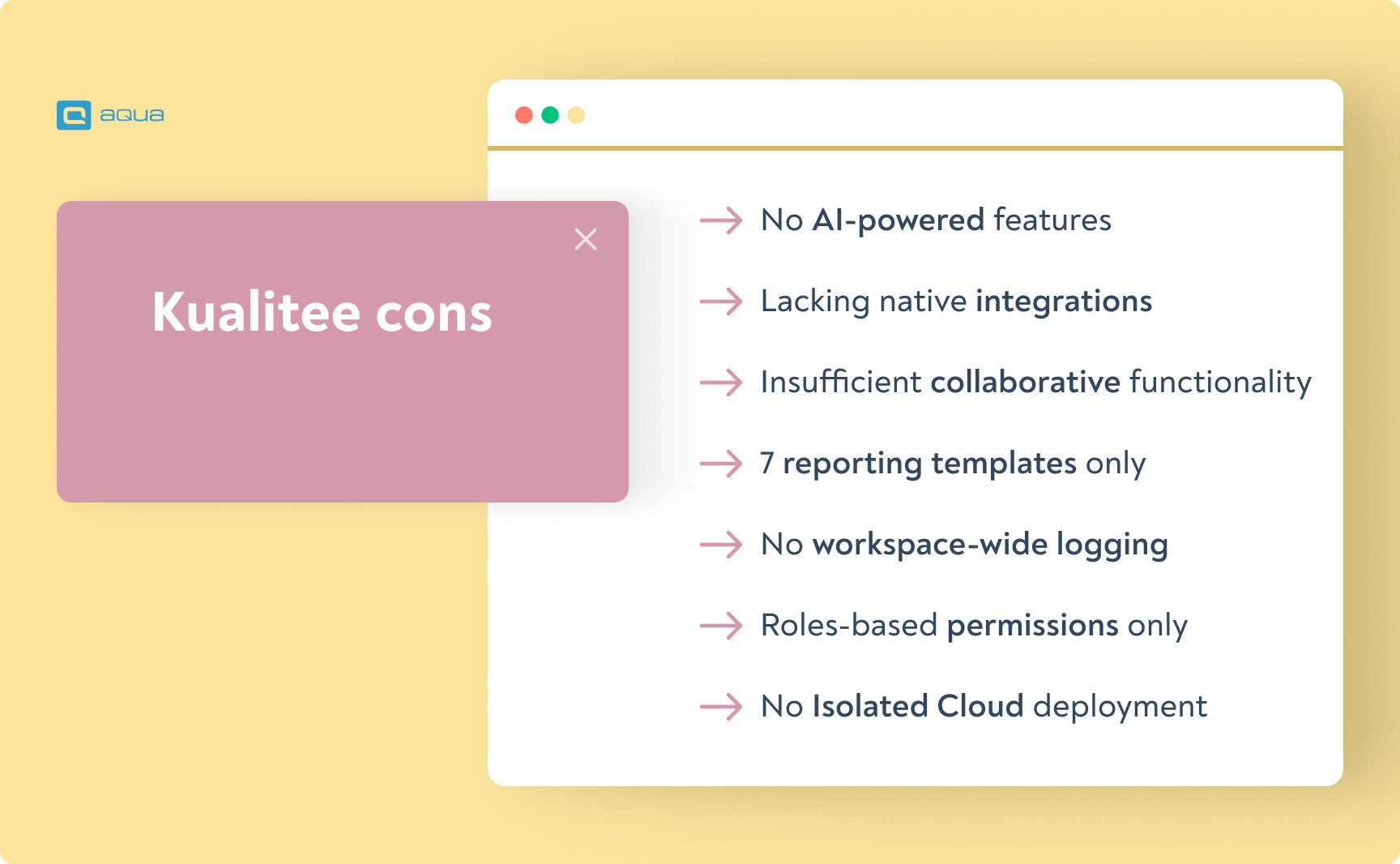About Kualitee
Kualitee is one of the newest tools in the market, launching in 2016. It is run by Kualitatem, an American company that has been offering QA consulting in various verticals for a decade.
Kualitee has become a capable test management solution. Some functionality, however, has not been developed at the same pace as the core features. There are a couple of deal breakers for Enterprise companies, too.
Pros & cons of using Kualitee
Pros
- Kualitee ticks most of the QA boxes. You can use:
- Test cases
- Test scenarios
- Bulk test edits
- Custom fields
- Execution history
- Item change history
- Views
- Kualitee has serviceable dashboards. While 15 key slices is below the industry’s best, they get the job done.
- Kualitee offers subsidised viewer licences. This works best for teams that use other tools to handle development and project management. Not everyone needs access to all Kualitee features, so it’s only fair that these people don’t need a full licence to sync with colleagues.
Cons
- There is no AI-powered functionality. While competitors increasingly create QA-minded alternatives to ChatGPT, Kualitee does not have such functionality as of now.
- Native integrations are lacking. Selenium is the only QA solution on the list, and it even has a separate tab in Kualitee. Other must-use tools like Ranorex, SoapUI, and JMeter will all need to be connected and managed via REST API.
- The collaborative feature suite has glaring omissions. There are no shared views to quickly get an overview from the teammate’s point of view. The lack of item change reversal means you would have to manually restore the ticket after an unauthorised edit.
- Reports are limited to 7 templates only. The customisation goes only as deep as filtering out test cases by field values in a test case report. You can’t use any custom data, add scripts, or bring external images into the report.
- Workspace-wide logging is not available. This will get in the way of traceability and may be a deal breaker for companies in heavily regulated industries.
- Permissions are limited to roles only. You can’t grant or revoke access privileges on a per-user basis.
- Isolated Cloud deployment is not offered. It would have struck a nice balance between Kualitee’s US Cloud and On-Premise deployment. Hosting on some other cloud server is also mandatory if you don’t want to go On-Premise but need to be GDPR-compliant. Alas, this is not an option with Kualitee.

Here are a couple of Kualitee reviews to illustrate our points:
“The user interface is not friendly, but the features are very good. Sometimes it takes time to load, and the page is not responsive. It would be great if adding test cases into the test execution cycle was faster.”
“Not user friendly, it's confusing and not always helpful. The audit trail for each defect doesn't do a good job of recording past history and hence, data becomes hard to analyse.”
List of Kualitee alternatives
Now that you know the key flaws of Kualitee, let’s look at tools that address them and even offer something extra.
Mature Enterprise TMS with AI: aqua
aqua cloud is a tool with a very similar background compared to Kualitee. It was launched by andagon group GmbH, which offered QA consulting for over 10 years before creating a test management solution. aqua has been running since 2013 and keeps receiving frequent feature updates.
Pros:
- aqua offers the most comprehensive AI feature set. You can:
- Generate tests for new requirements (aqua can be your ALM, too)
- Update tests in one click after a requirement changed
- Use voice narration to start writing a requirement, then complete it with AI
- Converse with the AI chat assistant to validate ideas or even spot duplicates
- Manually provide the context for desired AI output or allow it to learn from your workspace
- aqua nails compliance for regulated industries. You get full logging for both individual projects and the entire workspace. Custom workflows can mandate a senior’s approval for every impactful action as dictated in sensitive verticals. Even aqua’s own Cloud is GDPR-compliant, and you can host Cloud elsewhere or choose On-Premise if needed.
The track record is the best indicator here. Germany’s financial supervisory BaFin uses aqua to run their software testing. A dozen of government agencies, insurance companies, and banks are using aqua as well.
- aqua offers perhaps the most granular user access management in the industry. You can assign 100+ permissions to individual users or use custom groups if that is more convenient. While not a strict requirement, BaFin in Germany uses the precision of user access controls as one of the audit criteria.
- aqua brings a very sensible integrations package. You can connect 10+ industry leading tools like Ranorex, SoapUI, and JMeter out of the box. There is also a 2-way real-time Jira integration. Any other solution, including various issue trackers, can be connected with REST API in just 15 minutes.
- aqua has an industry-leading reports wizard. You can choose a pre-configured template, but the real depth lies in customisation. You can use any data from aqua or add something that you don’t actually have in your aqua workspace. You can use self-updating scripts to process data. If regular diagrams are not enough, pivot tables are at your service.
- aqua dashboards don’t make you look at them — they look out for you. The KPI alerts functionality notifies you when there is an anomaly in one of the metrics. You can then take a look at the dashboard or simply ask your colleague at the daily meeting if something is wrong.
Industry-leading testing with AI
Cons:
- No esignature functionality (but you can still use workflows for approvals)
- Native integrations cover 10+ QA tools, but you will need to spend 15 minutes with REST API to connect most issue trackers
“The reporting is meaningful and provides a good basis for decisions. After the employees have used aqua, they recognize the added value very quickly.”
Find more details in our aqua vs Kualitee comparison.
Feature-rich Jira plugin: Xray
Xray is the quintessential plugin for test management. It brings the convenience of doing everything in Jira, but also suffers from both regular and QA-specific limitations of Jira.
Pros:
- Easy to get started. You simply go to Atlassian Marketplace, find the plugin, pay the fee and begin doing testing in Jira.
- Handles the essential of quality assurance. You can create, group, and execute tests to analyse results and file bug reports. After all, Jira even has native defect management functionality.
- Offers basic QA dashboards. Most plugins display only what Jira could have displayed anyway, but Xray has 6 software tester dashboards.
Cons:
- On-Premise support stops when Jira’s does. And Jira stops On-Premise support as soon as January 1, 2024.
- The plugin nature makes licensing excessive. You need to buy a licence for all your Jira tenants even if they won’t ever touch Xray.
- Test automation relies on DIY frameworks. This takes effort and can be unreliable: the Cucumber framework recently ceased commercial development.
- QA reports are very awkward to configure. You need to create a manual Word/Excel template, then give it to Xray just to organise some data as text.
- Extra dependency. Jira can and does go down. It would be unfortunate if your devs made everything for a release, but now testers can’t perform QA because Xray is down alongside Jira.
“According to me, Xray is the best test management tool in Jira. The only thing that bothers a lot is the order of test cases gets disorganised each time a test execution or test plan gets created.”
Closest sidegrade: Qase
Kualitee alternative to look at but it is worth consideration.
Pros:
- Smart UX from day 1. Unlike long-established tools such as Micro Focus Quality Center, Qase does not struggle to make UX flows up to date. They have always been convenient.
- Basic AI functionality, although it’s only small test generation for now
- Extensive dashboards: 23 widgets is above the industry benchmark
Cons:
- On-Premise is not supported
- AI functionality is still limited to simple tests
- No reporting functionality
- Dashboards lack KPI alerts
- Poor scalability
- No views or shared views
- Workflows are not available
“There is one area where I feel Qase could improve: the process of writing test steps for similar cases. While the platform provides some tools to make this easier, writing out the same steps for multiple cases with similar characteristics can still be quite time-consuming and tedious“.
Conclusion
There is no one-for-one free Kualitee alternative. The tools from this list, however, can do what Kualitee does (and much more) at different budgets. For Enterprise companies, aqua is the only alternative offering On-Premise along with a high level of security, traceability, and regulatory compliance. Xray brings the ease of use, even if competitors have a tight Jira integration too. Qase has better dashboards. aqua is the only Enterprise alternative here that supports and actively maintains an On-Premise offering.
aqua, however, gives more than just On-Premise support. It is a test management solution that brings new features on top of a regulatory-proof foundation. Cutting-edge AI features do not take all the spotlight: test management, automation, and collaboration are all constantly improved as well.
Enterprise-ready Kualitee alternative


















